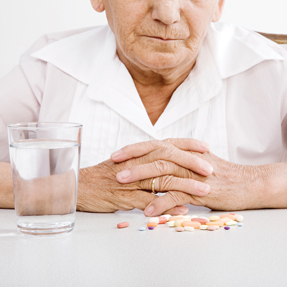Taking a drink: what patients should know
Alcohol is associated with so many benefits and harms that it's hard to know where to start talking to patients about using it. One place might be alcohol misuse and abuse. Teach patients where they fall on the continuum of drinking behavior.
When it comes to patients' alcohol consumption, the “who” and “how much” are important, but the “what” is probably not.
Research on alcohol's health benefits and risks has shown that ethanol works the same whether it is consumed in a glass of red wine, a bottle of beer or a gin and tonic. The amount and frequency of consumption, along with the drinker's gender, age, medical condition and history, family history, and medications, are all linked with the effect of ethanol over time.

Patrick G. O’Connor, MD, MPH, FACP, professor of medicine and chief of internal medicine at Yale School of Medicine, advises primary care physicians to routinely screen every patient about daily and weekly alcohol consumption.
“It is such a common and fundamental issue that if you don't ask all patients, you are going to be missing many who could benefit from what you have to offer in terms of improving your patients' health,” he said.
Long-term observational studies have highlighted a few key points about alcohol consumption: Benefit seems limited to the cardiovascular system in people over age 50 if they do not exceed the recommended number of servings per week. Risk includes development of breast cancer in women, particularly those who consume more than a few servings a week. Heavy drinking imposes significant risks for osteoporosis, many types of cancer, liver disease, hypertension, atrial fibrillation, stroke and multiple social and behavioral problems.
It's important to know where your patients fall on that drinking continuum. About 30% of the U.S. population misuses alcohol, according to a report from the U.S. Preventive Services Task Force (USPSTF) published in the Sept. 25, 2012, Annals of Internal Medicine. The USPSTF reported that 21.3% of patients in primary care are risky drinkers who consume on average more than four drinks per day if they are men or more than two drinks per day if they are women.
“The topic of alcohol habits should be asked by every health practitioner of every patient who comes for care,” said Arthur Klatsky, MD, FACP, adjunct investigator at the Kaiser Permanente Northern California Division of Research and senior consultant in cardiology at Kaiser Permanente. “These questions about alcohol consumption should be asked routinely, objectively, nonjudgmentally, just like questions are asked about smoking and family history.”
Recommended guidelines
The messages about alcohol consumption continue to be confusing, but internists can help patients sift through that information. They should start by:
- explaining what is currently known about the benefits and risks,
- providing information about the recommended daily and weekly limits, and
- educating patients about how age, gender, medical and family history, and the effect of alcohol when combined with certain medications should be considered in their decision making.
The National Institute on Alcohol Abuse and Alcoholism (NIAAA) recommends three or fewer standard drinks per day (≤seven per week) for women and anyone older than age 65, and four or fewer standard drinks per day (≤14 per week) for men younger than age 65. In other words, it recommends no more than seven drinks per week for women, without exceeding three drinks on any day, and no more than 14 per week for men, without exceeding four drinks on any day. The American Cancer Society, the American Society of Clinical Oncology, and the American Heart Association all recommend no more than one drink per day for women and one to two for men.
The definition of a drink in all of the recommendations is 12 oz of regular beer (which contains about 5% alcohol), 5 oz of red or white table wine (about 12% alcohol), or 1.5 oz of 80-proof spirits (about 40% alcohol). Those standard-size drinks each contain about 12.5 to 15 mL of pure ethyl alcohol (see Table).
Understanding the difference between serving size and alcohol content is important. Anyone tempted to drink a glass of the new Scottish beer Armageddon, with a reported 65% alcohol content, should understand that just one 330-mL (11.6-oz) bottle of that beer far exceeds the total weekly limit for women and is close to the total weekly limit for men.
Although the effects of alcohol are somewhat tied to body mass, the daily/weekly alcohol recommendations are gender-based for a reason. Women have less water in their bodies than men and also have lower levels of the enzyme that metabolizes alcohol. They therefore experience higher blood alcohol concentrations than men who consume similar amounts of ethanol/kg of body weight, according to Dr. O’Connor's chapter on alcohol abuse and dependence in Goldman's Cecil Medicine, 24th edition.
The recommendations make no distinction between red and white wine and other types of alcohol because they all contain ethanol, and it's the ethanol that makes the difference. A common misconception is that red wine's resveratrol or phenolic content makes it the more healthful choice, but that argument is overstated, Dr. Klatsky said: “The longevity studies in animal models require huge doses that you cannot possibly do.”
Cardiovascular benefit
Although heavy drinking and binge drinking are high-risk behaviors for cardiovascular mortality and cancer, light to moderate drinking has been found to be cardioprotective for certain people at certain ages, said Dr. Klatsky.
In a 2010 article in Physiology & Behavior, he noted that nearly all epidemiologic studies have found a reduced risk of acute myocardial infarction and coronary artery disease death in moderate drinkers compared with abstainers. This reduced risk is attributed to an increased level of high-density lipoprotein cholesterol conferred by alcohol, thus limiting plaque buildup in blood vessel walls. Alcohol also seems to inhibit several promoters of clotting, including platelet stickiness and fibrinogen levels, according to Dr. Klatsky.
“If you study a young population, you are not going to see any benefit because they don't die of coronary disease or get heart attacks very often, particularly young women. But if you study middle-aged and older men, then the benefit [of light to moderate alcohol consumption] will be more apparent,” he said.
The increased risk of breast cancer in moderate female drinkers outweighs any of the cardiovascular benefit of alcohol in women younger than age 50, but in postmenopausal women the cardiovascular benefit for total mortality outweighs the breast cancer risk, Dr. Klatsky said.
Drinking patterns also have been linked with cardiovascular benefit and risk. A 2006 article in Vascular Health and Risk Management reported that drinking with meals seems to have a beneficial effect on cardiovascular risk, possibly due to the effect on blood pressure, thrombotic factors or lipids. The article noted that light to moderate drinking seems to reduce major vascular risk in middle-aged people by about 20%, which includes a reduction in risk of ischemic stroke. Binge drinking, however, is linked with increased cardiovascular risk.
A report in Heart Rhythm in 2011 about the risk of sudden cardiac death (SCD) in women reported that the lowest risk occurred among those who consumed approximately one-half to one drink per day. Their risk was 36% lower when compared with abstainers.
The authors said that the results support evidence that consumption by women of up to one drink per day is related to lower risk of not only SCD but also coronary heart disease (CHD), stroke and congestive heart failure. Higher intake, they said, may be associated with lower risk of overall CHD but also a greater risk of atrial fibrillation, stroke and cancer.
Cancer risk
There's a clear link between alcohol consumption and cancer risk, and no data suggest that alcohol would be helpful for cancer prevention, according to Wendy Y. Chen, MD, MPH, a medical oncologist at Dana-Farber Cancer Institute in Boston and first author of a paper about moderate alcohol consumption and breast cancer risk published in Journal of the American Medical Association in 2011.
“There is clearly a dose-response relationship between people developing breast cancer for the first time and alcohol consumption, regardless of whether it's wine, beer or liquor,” she said.
The research by Dr. Chen and colleagues was based on long-term data from the Nurses' Health Study. They found that consumption of three to six drinks per week was modestly but significantly associated with a 15% increased risk of breast cancer. Women who consumed at least two drinks per day had a 51% increased risk compared with women who never consumed alcohol.
Drinking in both early and later life was independently associated with breast cancer risk, and there was a modest association with binge drinking but not with frequency of drinking. The researchers observed a 10% increase in risk with each 10 g of alcohol consumed per day.
This increased risk may be linked to alcohol's effects on circulating estrogen levels, with a stronger association found between alcohol consumption and estrogen-positive breast cancer.
“People who were regular drinkers had higher estrogen levels than nondrinkers,” Dr. Chen said.
There was also an association with drinking between the ages of 18 and 40 and future breast cancer risk.
“If someone drank more at a younger age and then drank less later in life, or the opposite, then it averaged out the same and their risk was the same,” Dr. Chen said. “It was what their average use was over a long period of time that conveyed risk, not what they drank in a particular decade of life.”
Women concerned about their risk of cancer or women who have survived breast cancer should limit consumption to no more than two to three drinks per week, Dr. Chen advised. Any decision about alcohol consumption, she said, must “weigh the modest risks of light to moderate alcohol use on breast cancer development against the beneficial effects on cardiovascular disease to make the best personal choice.”
Risk for other types of cancer is also linked with alcohol consumption. Results of the prospective Million Women Study, conducted in the U.K. and published in the Journal of the National Cancer Institute in 2009, found that each additional drink regularly consumed per day may account for approximately 11 more cases of breast cancer per 1,000 women, one additional case of cancer of the oral cavity and pharynx and rectum, and 0.7 case each of cancers of the esophagus, larynx and liver.
The National Health Interview Survey, published in American Journal of Epidemiology in 2011, showed a similar pattern. Higher quantity drinking (=three drinks per day vs. one drink per day) increased the all-site cancer mortality risk among men and women, as well as increased risk of colorectal cancer mortality in women and increased risk of prostate cancer among men.
Advising patients
Daniel E. Jonas, MD, MPH, an assistant professor of medicine at the University of North Carolina at Chapel Hill and first author of the recent systematic review for the USPSTF, said that a primary care physician's alcohol screening program can be as simple as posing two questions: “Do you sometimes drink beer, wine or other alcoholic beverages?”
If the answer is yes, patients should be asked how many times in the past year they have consumed four or more (for women or those over 65) or five or more (for men up to 65) drinks in a day.
Patients who have done so should be evaluated further to determine whether they may benefit from a behavioral counseling intervention for risky drinking behavior, or whether treatment for an alcohol use disorder is more appropriate.
“The risk for health problems is increased for people who drink four or five drinks on any occasion, and for those who drink above the recommended weekly amounts,” Dr. Jonas said. “In talking with patients who are not in the risky drinking category (i.e., they engage only in healthy alcohol use), I tell them that if they stay in the one to two drinks per day realm—one or fewer for women and two or fewer for men—they may reduce their risk of coronary heart disease.”
The discussion should change for any patient with a strong family history of cancer or with increased risk of cancer. In addition, other conditions should prompt a discussion about the need to abstain from alcohol, including pregnancy, an alcohol use disorder, poorly controlled hypertension, peptic ulcer disease, liver disease (including hepatitis C), and many types of cancer, as well as some mental health conditions such as anxiety or depression that can be exacerbated in some people who drink.
“For each individual, it should be based on that patient's personal medical history, their preferences and values, their family history, and the medications they are taking,” Dr. Jonas said. “Any of that can take you in a different direction in the discussion.”





